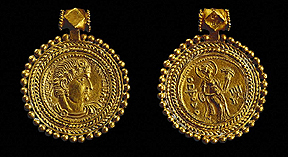
North-western Pakistan (?), 4th century AD
Gold
Diameter: 3.5 cm
Weight: 19.98 g
Acquisition number: #CM OR 5200
Image courtesy of the British Museum (copyright reserved)
At a glance, this pendant purports be created from a gold Roman coin minted during the reign of Constantine the Great (reigned 307-337 CE). On closer examination, however, we discover that the object is in fact a pastiche, incorporating designs based upon a Roman and a Kushan coin. The front side appears as a passable imitation of Constantine's portrait, but the Latin legend giving the emperor's name and title has been blundered by the artisan. The reverse side goes east for its model, mimicking a coin cast by the Kushan emperor Kanishka I (reigned approximately 120-146 CE). The lettering here, this time in Bactrian but written in Greek, has also been miscopied, but it is legible enough to identify the subject as Ardochsho, goddess of good fortune.1
Since similar pendants dating to approximately the same period have been found in the Bactrian region of Pakistan, a fact that supplies a theoretical provenance. Bactria had once been under the control of the Kushan Empire, but by the fourth century the Sassanians exerted control over the region. Though the relationship between the Sassanians and Rome was often stormy, Roman coins might have been considered somewhat exotic in these easternmost reaches of the Sassanian Empire. This would explain the impetus to convert a coin into jewelry, or even to imitate one if no real coins were available to the goldsmith.
(1) See the British Museum web page dedicated to this object.